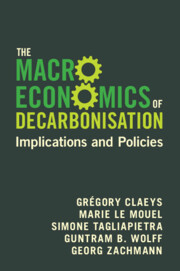Book contents
- The Macroeconomics of Decarbonisation
- Reviews
- The Macroeconomics of Decarbonisation
- Copyright page
- Contents
- Figures
- Tables
- Boxes
- Introduction
- 1 Understanding Deep Decarbonisation over the Long Run
- 2 Understanding Decarbonisation’s Short-Term Disruptions to Economic Activity
- 3 The Distributional Effects of Climate Policy
- 4 Public Finances and Decarbonisation
- 5 Greening Innovation, Industrial and Competition Policies
- 6 Mobilising the Financial System for Decarbonisation
- 7 Decarbonisation and Labour Markets
- 8 Greening Central Banks
- Conclusions
- Index
- References
7 - Decarbonisation and Labour Markets
Published online by Cambridge University Press: 01 February 2024
- The Macroeconomics of Decarbonisation
- Reviews
- The Macroeconomics of Decarbonisation
- Copyright page
- Contents
- Figures
- Tables
- Boxes
- Introduction
- 1 Understanding Deep Decarbonisation over the Long Run
- 2 Understanding Decarbonisation’s Short-Term Disruptions to Economic Activity
- 3 The Distributional Effects of Climate Policy
- 4 Public Finances and Decarbonisation
- 5 Greening Innovation, Industrial and Competition Policies
- 6 Mobilising the Financial System for Decarbonisation
- 7 Decarbonisation and Labour Markets
- 8 Greening Central Banks
- Conclusions
- Index
- References
Summary
This chapter explains the consequences on the labour market of the structural changes induced by decarbonisation policies. These policies are indeed likely going to have consequences on labour income distribution given existing rigidities in the labour markets and their different impacts on sectors and job categories. The chapter notably discusses whether decarbonisation can be a net job creator or destroyer, illustrating how job losses can be managed in a fair manner and how green jobs creation can be incentivised.
- Type
- Chapter
- Information
- The Macroeconomics of DecarbonisationImplications and Policies, pp. 251 - 290Publisher: Cambridge University PressPrint publication year: 2024



